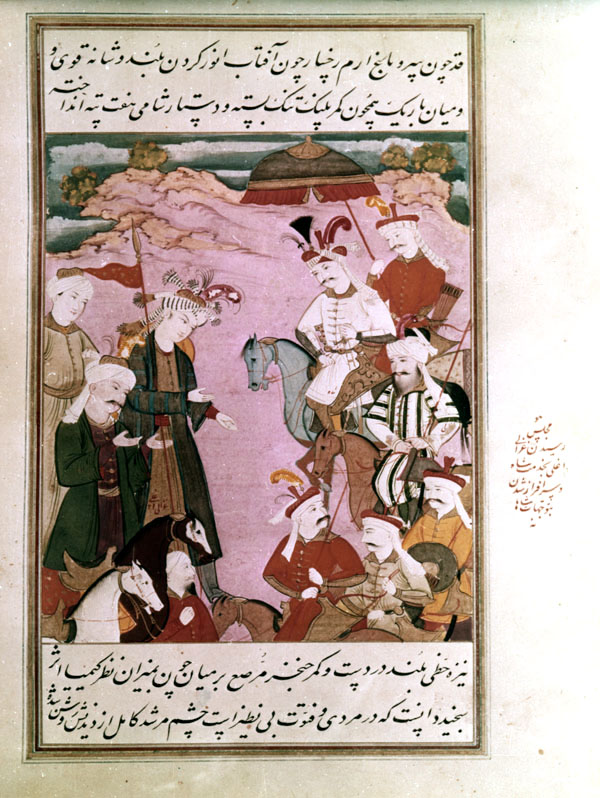Manuscripts
tāriḵ-e ʿālām-ārā-ye šāh esmāʿil
Once Ḡazāli ʿArab had settled in his new land (cf. f.332v), he wrote a letter to his son Ḡazāli Oḡli, who had remained in Syria, telling him of the fine treatment he had received from Esmāʿil, and asking his son to gather all of the Arabs and join him in Iran. Upon receiving the letter, the young Ḡazāli summoned the Arab chieftains and related his father’s words, and much to his surprise they recounted an ancestral debt owed to the Safavids. Many years earlier their forefathers had been captured by Timur who was taking them captive back to Samarkand, when Esmāʿil’s ancestor Sultan Ḵˇāja ʿAli Siāh Puš obtained their release (cf. f.17). Subsequent generations continued to respect and admire the Safavid successors of Sultan ʿAli, and in response to this invitation the Arab chieftains decided to gather all their belongings, and under the lead of Ḡazāli Oḡli, to make the mass movement in the direction of Azerbaijan.
At first, the Ottomans tried to verbally dissuade them from going, but when this failed, physically attempted to prevent them with armed force. Several battles took place during which, if the text is to be believed, enormous numbers were killed on each side. Eventually, however, despite the obstacles, they succeeded in reaching their destination where Aḥmad Solṭān Qājār, the Safavid governor of Qarā Ḥamid, came out to greet them. News of their arrival was immediately sent to Shah Esmāʿil, who dispatched Div Solṭān Rumlu with gifts of luxurious clothing for Ḡazāli Oḡli and his headmen, together with an invitation to meet with him. But the army of Arabs accompanying Ḡazāli Oḡli also wanted to see the shah to whom they felt so indebted, and insisted on accompanying him to the meeting. Together 100,000 strong, they rode to meet the shah. The meeting was cordial with a full exchange of respect and pleasantry, after which the Arab army and families were invited to settle in Šuš (Susa), and Ḡazāli Oḡli was retained by the shah as a confident.
The painting depicts the meeting of Shah Esmāʿil and Ḡazāli Oḡli. The Safavids are grouped on the right, Ḡazāli Oḡli and the Arabs on the left, and in the center running from top to bottom is a space that clearly separates the two groups. Shah Esmāʿil,

dressed in his now familiar white coat and flat-top tāj, sits astride a gray horse in the upper right. A mounted qezelbāš, dressed in vermillion, is directly behind him holding the vermillion, gray, and gold ceremonial umbrella of kingship over Esmāʿil’s head. More towards the foreground and immediately to the shah’s left, a bearded man dressed in a black and white striped robe and white turban sits astride a chestnut colored horse. He is identified by inscription as Ḡazāli, meaning Ḡazāli ʿArab, the father of Ḡazāli Oḡli and now one of Esmāʿil’s followers. In the near foreground, the lower right of the comosition, are three additional mounted qezelbāš, dressed in vermillion, beige, and yellow-orange respectively.
On the left side of the composition, the dominant figure, identified by inscription, is of course the young Ḡazāli Oḡli. He wears a striped turban with loose ends, a green and blue striped coat with a beige robe underneath, holds a standard, and stretches his arms out in supplication. Immediately to his right is another dignitary of unknown identification but apparently one of the Arab chieftains. He wears a white turban, purple robe, green top coat, and repeats Ḡazāli Oḡli’s gesture. The two have dismounted and are standing next to their mounts whose forequarters are visible in the lower left. The saddled horses are retained by a single bearded groom dressed in vermillion. Behind Ḡazāli Oḡli, on the far left, is a standing attendant, in beige with a white turban. The background is simply treated. A light pinkish-mauve hillside rises to a craggy rock formation near the top, with four insignificant suggestions of foliage, and a narrow band of blue sky with clouds at the top.
Painting: 16.0 x 13.2 cm. Two lines of text above and below the paining. Frame encloses painting and text. A marginal inscription in red, presumably of later date, describes the event depicted. Inscriptions, also in red, appear on three of the figures, identifying two of them as Shah Esmāʿil and Ḡazāli Oḡli. Just a lam and ye remain of the inscription on the third figure, but undoubtedly this originally read Ḡazāli, meaning Ḡazāli ʿArab. There is similar damage to the other sleeve of the same personage, but there are no other indications of damage or retouching.
Painting references:
Mahboubian_1972, #923 folio 339v (not ill.).
Text references:
Muntaẓer-Ṣāḥeb_1970, pp.591-92.
Robert Eng
Last Updated: December 20, 2010
Originally published: April 4, 2002